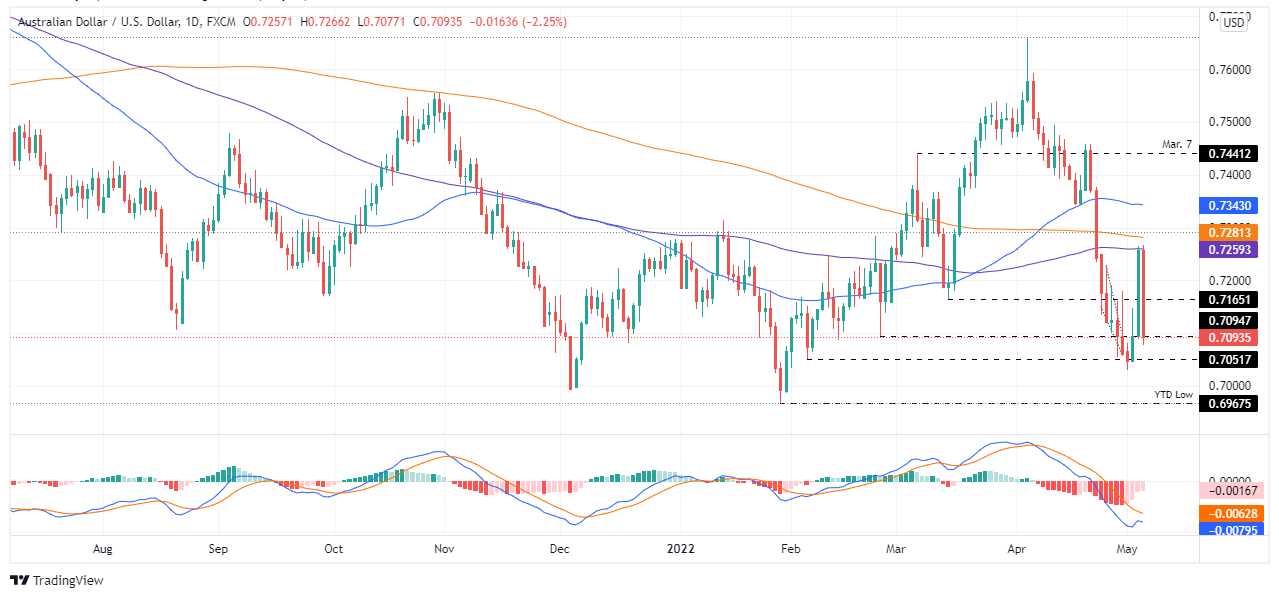- The AUD/USD is making a U-turn and is losing 2.33% during the day.
- The central bank’s tightening and China’s Covid-19 lockdowns cloud the global economic outlook.
- AUD/USD Price Forecast: Failure at the 100-DMA exacerbated the 160-pip fall, as bears eye 0.7000.
The Australian dollar losses ground and gave back Wednesday’s gains amidst a risk-off market mood, courtesy of central bank tightening, alongside China’s weak service and composite PMIs, and also the acknowledgment of its coronavirus crisis by the Fed and the Bank of England. At the time of writing, the AUD/USD is trading at 0.7093.
Central bank tightening and China’s Covid-19 lockdowns dampened the market mood
The market sentiment dampened as the Bank of England’s press conference was undergoing in the middle of the European session. The BoE hiked rates by 25-bps in line with expectations and expressed its concerns about China’s ongoing Covid-19 crisis, which according to the BoE, threatens to hit supply chains again and add to inflation pressures. Adding to the abovementioned, the Fed mentioned in the FOMC statement that “… COVID-related lockdowns in China are likely to exacerbate supply chain disruptions.”
In a note to clients, analysts at Brown Brothers Harriman (BBH) wrote that the Chinese economy “is clearly staggering from Xi’s COVID Zero policy. While policymakers have pledged more stimulus, it is unlikely to be very effective until the hard lockdowns have ended.”
Reflection of the previous mentioned are US equities, which are plunging as the New York session winds down. Contrarily, US Treasury yields are soaring, with the US 10-year Treasury yield, reaching 3.10% for the first time since 2018, underpinning the greenback. The US Dollar Index, a gauge of the buck’s value against a basket of peers, records gains of 1.24% and sits at 103.782.
Meanwhile, on Wednesday, the Fed continued taking measures to tame inflation. The US central bank lifted rates by 0.50%, up to the 1% threshold, and announced the beginning of Quantitative Tightening (QT) by $47.5 billion in the first three months. Later, Fed Chair Jerome Powell said that 75-bps hikes were not discussed in the meeting, though it opened the door for at least a “couple” of 50-bps increases. Nevertheless, money market futures show 71% odds of a 75-bps rate hike by the June meeting while fully pricing a 50-bps raise.
Data-wise, the US Department of Labour reported the Initial Jobless Claims for the last week of April, showing an increase in unemployment claims of 200K, higher than the 182K estimated.
The Australian economic docket displayed mixed data, with the Balance Trade printing a surplus of A$ 9.314 billion. On the negative side, Building Permits and Private House Approvals disappointed market players, weighing on the AUD/USD.
In the week ahead, the Australian docket will feature the Statement on Monetary Policy. Across the pond, the US Nonfarm Payrolls report for April estimates the creation of 391K of jobs in the US economy. Regarding the Unemployment Rate is expected to dip to 3.5%.
AUD/USD Price Forecast: Technical outlook
AUD/USD price action in the last two trading sessions is forming a tweezers-top pattern, which, once confirmed, means that further downside pressure lies ahead. The AUD/USD faced solid resistance around the 100-day moving average (DMA) at 0.7259, a level that AUD bulls could not reclaim, leaving the AUD/USD vulnerable to heavy selling pressure IF market sentiment shifted. Therefore, the AUD/USD remains downward biased.
With that said, the AUD/USD’s first support would be February’s 4 daily low at 0.7051. Break below would expose May’s 2 swing low at 0.7029, followed by the YTD low at 0.6967.





